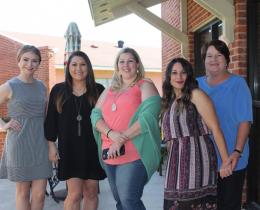
Jim Bradshaw
C’est Vrai: Scholar and the 4-H Clubs
When the railroad crossed the south Louisiana prairies in 1880, land that was once thought of only as grazing land for wild cattle became accessible to farmers from the Midwest who saw in our benign climate and fertile soil a land of milk and honey.
Southern Pacific actively recruited these dreamers and they flocked to south Louisiana, primarily to establish the farms that would become the basis of Louisiana’s rice industry.
One of those emigres was Seaman A. Knapp, a farmer and educator who soon had wide influence in south Louisiana and, eventually, across the nation. He is recognized as the man who firmly established the Cooperative Extension Service through which demonstration agents introduced new concepts to farmers.
Knapp was born Dec. 16, 1832, at Schroon Lake in northern New York, the youngest of eight children. When he was 15 his oldest brother, Alonso, got sick and Seaman took charge of his cabinet shop, apparently becoming a pretty good furniture maker. Alonso vigorously opposed Seaman’s decision to go to college the next year, claiming further education would ruin a fine cabinet maker and turn out a mediocre scholar.
Nonetheless, Seaman borrowed tuition from his sister Mary and entered Troy Conference Academy, a Methodist school in Vermont, at the age of 16. He studied there for two years, but, perhaps more important, that is where he met Maria Elizabeth Hotchkiss, who became his wife, counselor, and companion for 54 years.
At 18, Seaman moved to Union College in Schenectady, N.Y., from which he graduated with honors, and shortly after began his career as a teacher and college administrator. He taught in New York until 1866, when he moved to Iowa, to try his hand at raising sheep. But, partly because of an injury to his leg that made farm life too difficult for him and largely because of a brutal winter that decimated his flock, he had to give it up. He preached for two years at the Methodist church in Vinton, Iowa, (from which the Louisiana town gets its name), then, working in a wheelchair, became superintendent of Iowa College for the Blind, all the while working to rehabilitate the leg that made it impossible for him to walk.
In 1876, when he was able to move about on crutches, he established a pig farm and also began to edit a newspaper for Iowa farmers. That brought him to the attention of Iowa educators who invited him to become professor of agriculture at the new Iowa State College.
He came to Louisiana in 1885. This was the time when Kansas banker J.B. Watkins, began buying up hundreds of thousands of acres in southwest Louisiana. Watkins thought he could improve the land, bring farmers to it, and make a lot of money in the deal, and eventually did just that. His brother-in-law, Professor Alexander Thomson, came with Watkins, and Thomson lured fellow educator Knapp to Lake Charles, where he lived for the next 22 years. During those years federal agriculture administrators began to take more and more notice of him.
In 1898 he was sent to study rice farming methods in Japan, China, the Philippines, and elsewhere, a tour that brought introduction of the improved varieties that made the local rice industry prosper.
His demonstration work began in 1904, when the boll weevil was threatening the nation’s cotton crop. He visited dozens of farmers in Texas to show them exactly what to do and how to share the better methods with their neighbors, and also to introduce the idea of diversifying crops and growing more corn, feed grains, and produce. As part of his demonstration work, Knapp formed Boys Corn Clubs and Girls Canning Clubs in many of the places he visited. All of that caused him to be called to Washington to oversee the expansion of the farm demonstration system across the South.
It was successful and rewarding work. When he died on April 1, 1911, at the age of 78, more than 700 instructors were visiting thousands of farmers each year and more than 60,000 boys and girls were enrolled in the organizations that today we know as 4-H Clubs.
Newspapers across the South called for “a fitting memorial” almost immediately after getting word of his death. The tribute in the Lafayette Advertiser was typical: “No other man in the history of the South ... ever did as much as Dr. Knapp to stir interest in better methods of farming ... and to get [farmers] out of their slavery to cotton. The demonstration work and the corn club work developed under his fostering care for the first time brought our people to see that ... there is no reason in nature why our farmers should be dependent upon a single crop.”
Knapp’s life and work are commemorated by a “fitting memorial,” a bridge across Independence Avenue in Washington, D.C., linking two Department of Agriculture buildings.
You can contact Jim Bradshaw at jimbradshaw4321@gmail.com or P.O. Box 1121, Washington LA 70589.
- Log in to post comments

